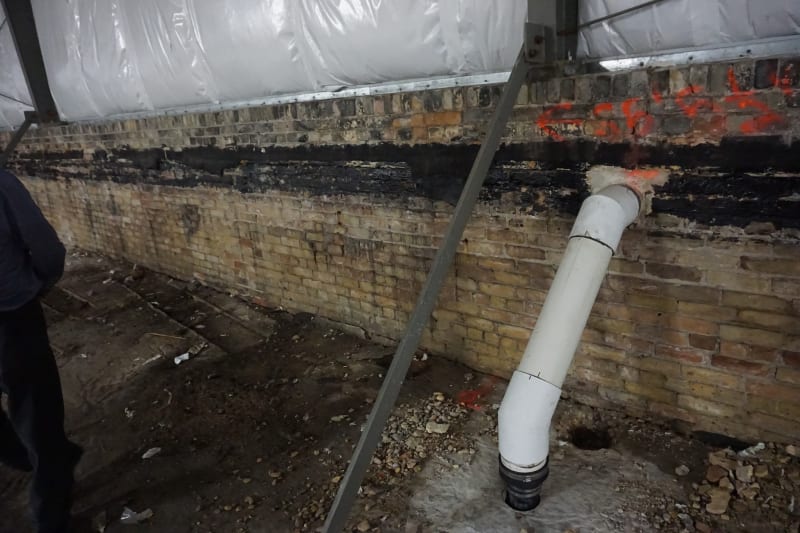dik
Structural
- Apr 13, 2001
- 26,032
Background
One of my projects is the addition to an existing six storey building. The original building was used for storage, and it’s being re-purposed to Residential. It is a flat slab construction with round columns and capitals and drops. The only sign of distress observed is on the 3rd floor with a narrow, but long, flexural crack at mid span. The crack is nearly half the length of the building. The floor with the crack had almost wall to wall 10’x10’ masonry partitions to create storage compartments. I suspect that this is the cause of the flexural crack observed. The original building is over 100 years old.
A PEMB was added to the top floor (to make it a 6 storey building) several years back. The exterior columns are supported on the original building brick parapet which is about 4’ high and 24” wide. The horizontal thrust is accommodated by diagonal angle struts fastened to the existing roof and the base of the exterior columns. I looked at replacing the struts by reinforcing the structure to behave like a continuous simple steel structure and found the framing members to be a little ‘light’. I calculated the capacity using a design dead load equal to 13psf; the original supplier may have used 10psf; I don’t know, but I expect that sort of design for PEMBs.
Now the Crux
The proposed renovation includes adding new load to the PEMB in the form of added insulation, ceiling and sprinklers. This will likely double the existing dead loading. Because the original design loading is light (or, very tight) I’m considering treating the existing PEMB regular steel building with continuous roof beams and adding BAR material to reinforce it for the moment caused by the added loading without moments at the exterior columns (like a PEMB), without going into a complicated rigid frame design. Can anyone suggest an alternative method or any pitfalls?
So strange to see the singularity approaching while the entire planet is rapidly turning into a hellscape. -John Coates
-Dik
One of my projects is the addition to an existing six storey building. The original building was used for storage, and it’s being re-purposed to Residential. It is a flat slab construction with round columns and capitals and drops. The only sign of distress observed is on the 3rd floor with a narrow, but long, flexural crack at mid span. The crack is nearly half the length of the building. The floor with the crack had almost wall to wall 10’x10’ masonry partitions to create storage compartments. I suspect that this is the cause of the flexural crack observed. The original building is over 100 years old.
A PEMB was added to the top floor (to make it a 6 storey building) several years back. The exterior columns are supported on the original building brick parapet which is about 4’ high and 24” wide. The horizontal thrust is accommodated by diagonal angle struts fastened to the existing roof and the base of the exterior columns. I looked at replacing the struts by reinforcing the structure to behave like a continuous simple steel structure and found the framing members to be a little ‘light’. I calculated the capacity using a design dead load equal to 13psf; the original supplier may have used 10psf; I don’t know, but I expect that sort of design for PEMBs.
Now the Crux
The proposed renovation includes adding new load to the PEMB in the form of added insulation, ceiling and sprinklers. This will likely double the existing dead loading. Because the original design loading is light (or, very tight) I’m considering treating the existing PEMB regular steel building with continuous roof beams and adding BAR material to reinforce it for the moment caused by the added loading without moments at the exterior columns (like a PEMB), without going into a complicated rigid frame design. Can anyone suggest an alternative method or any pitfalls?
So strange to see the singularity approaching while the entire planet is rapidly turning into a hellscape. -John Coates
-Dik

![[pipe] [pipe] [pipe]](/data/assets/smilies/pipe.gif)
![[ponder] [ponder] [ponder]](/data/assets/smilies/ponder.gif)


